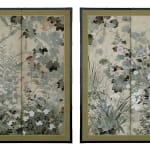School of Ogata Korin
Birds and Flowers of the Four Seasons, early 18th century
Pair of six-panel folding screens; ink, colors and gofun on paper
Size each screen 65¼ x 142½ in. (165.5 x 362 cm)
T-1009L
Further images
-
(View a larger image of thumbnail 1
)

-
(View a larger image of thumbnail 2
)

-
(View a larger image of thumbnail 3
)

-
(View a larger image of thumbnail 4
)

-
(View a larger image of thumbnail 5
)

-
(View a larger image of thumbnail 6
)

-
(View a larger image of thumbnail 7
)

-
(View a larger image of thumbnail 8
)

-
(View a larger image of thumbnail 9
)

-
(View a larger image of thumbnail 10
)

-
(View a larger image of thumbnail 11
)

-
(View a larger image of thumbnail 12
)

-
(View a larger image of thumbnail 13
)

-
(View a larger image of thumbnail 14
)

-
(View a larger image of thumbnail 15
)

-
(View a larger image of thumbnail 16
)

-
(View a larger image of thumbnail 17
)

-
(View a larger image of thumbnail 18
)

The artist has created a luxurious scene of the four seasons with a dense undergrowth of flowering plants and trees, which conceals not only additional flora, but also a pair...
The artist has created a luxurious scene of the four seasons with a dense
undergrowth of flowering plants and trees, which conceals not only additional flora,
but also a pair of quail and pheasants.
The spring flowers are wisteria, willow, thistle, kodamari, suzushiro, shakuyaku, and kobushi. The summer plants are represented by iris, lily, peony, an eggplant, mizuaoi, uri, and tsuyukusa. The autumn plants include bush clover, morning glory, gourds, and susuki, kikyō, keitō, nadeshiko, ominaeshi, kuzu. The sole winter plant is the pine. The autumn season is clearly favored, with the autumn flowers spread over both screens.
A favorite technique of Korin and Rimpa artists can be seen here, namely tarashikomi, a process of dripping ink of differing modality into ink and mineral pigments that have not yet dried, thus producing a mottled effect. In addition, the ink modalities are carefully varied in order to create a convincing sense of depth to the leafy undergrowth. There is clearly articulated layering of leaves, important in a work with this many leaves and flowers arranged on top of each other in a small space. The frame has the fine original hardware.
undergrowth of flowering plants and trees, which conceals not only additional flora,
but also a pair of quail and pheasants.
The spring flowers are wisteria, willow, thistle, kodamari, suzushiro, shakuyaku, and kobushi. The summer plants are represented by iris, lily, peony, an eggplant, mizuaoi, uri, and tsuyukusa. The autumn plants include bush clover, morning glory, gourds, and susuki, kikyō, keitō, nadeshiko, ominaeshi, kuzu. The sole winter plant is the pine. The autumn season is clearly favored, with the autumn flowers spread over both screens.
A favorite technique of Korin and Rimpa artists can be seen here, namely tarashikomi, a process of dripping ink of differing modality into ink and mineral pigments that have not yet dried, thus producing a mottled effect. In addition, the ink modalities are carefully varied in order to create a convincing sense of depth to the leafy undergrowth. There is clearly articulated layering of leaves, important in a work with this many leaves and flowers arranged on top of each other in a small space. The frame has the fine original hardware.
Publications
Catalog 2006.02

















